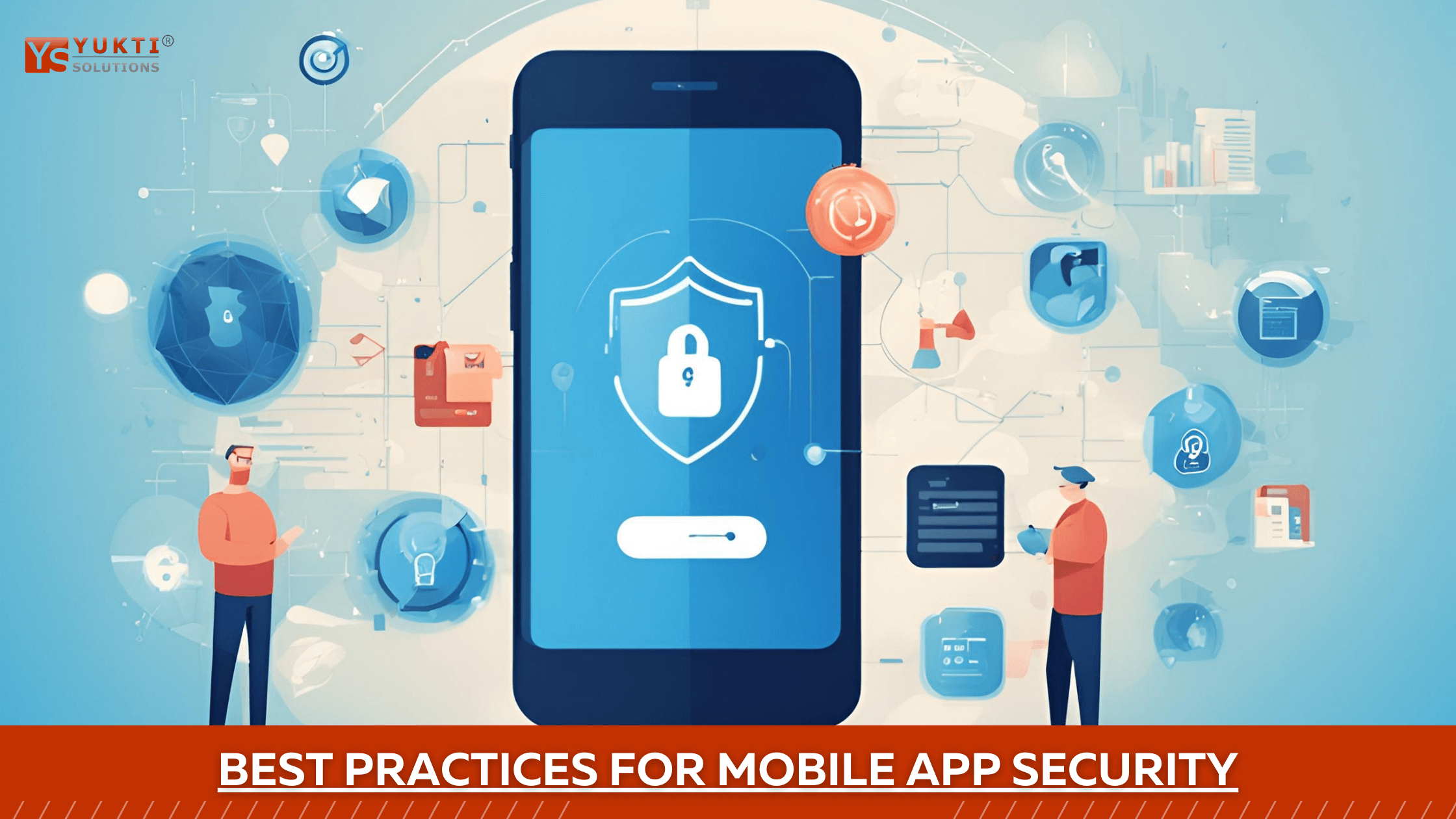Best Practices for (Android and iOS) Mobile App Security
It is important to describe and follow these best practices for mobile app security since mobile applications are under constant threat from various factors. Best Practices for...

Nowadays, mobile apps have become an essential part of our lives and are crucial for any business. They are used for both personal and business activities like communication with clients, including handling online transactions, managing finances, tracking productivity, etc. Since so much business data is being transmitted and processed using these apps, it is very important to protect them. But how can you protect your business apps from hackers and other malicious threats? In this particular read, let’s discuss some basic yet effective measures that can be adopted to safeguard mobile applications for both Android and iOS. Here are some tips that would be helpful for any business owner or developer to ensure proper mobile app security. Come on in and secure your business’s mobile experience.
It is therefore important to describe and follow the best practices for mobile app security since mobile applications are under constant threat from various factors such as insecure data storage, poor authentication procedures, and communication vulnerabilities. Failure to adopt strong mobile application security measures can lead to such adverse effects as theft of personal data, financial information, piracy of intellectual property, and damage to reputation. According to recent research, 75% of all apps launched globally have a major security flaw. Additionally, business apps are more vulnerable to data leakage than the average mobile app. So, businesses and developers need to prioritize robust security measures throughout the app development process.
Some Common Threats to Mobile App Security
When it comes to the threats that are likely to threaten the security of mobile apps, they include the following:
Data storage insecurity
Insecure storage of data is one of the most dangerous threats to mobile applications. If, for instance, login credentials, personal information, or financial details are not encrypted or stored properly, the wrong people can gain access to them and exploit them. Situations such as data leakage, identity theft, and financial losses arise from insecure data storage.
Faulty Server Controls
Many mobile applications use network communication to transfer data between the application and a server. Poor server controls, like inadequate authentication, no encryption, or insecure APIs, create a scenario where sensitive information is exposed during transit. This data is vulnerable to interception and exploitation by attackers, and this will lead to a compromise of the app.
Absence of Binary Protection
Mobile app binaries, which are the end product of an app development process, can be reversed by attackers to understand the app's functionality and how to find its weaknesses. The lack of binary layers of protection, including obfuscation, can be crucial since the code of the app becomes more vulnerable to attackers’ manipulation and injection of malicious code. Following best practices in coding is essential from start to finish in the app development process to reduce the risk of being vulnerable to attackers.
Best Practices for Securing Android Apps
1. Encryption of data on external storage
The data should be encrypted with a robust encryption technique and the Android Keystore to protect the encryption key in case the data is stored on an external storage device. Android uses a specific encryption algorithm called Extensible Encryption Standard (XTS) when storing data on external drives, ensuring that no unauthorized parties can access or manipulate it. If there is a need to load data or code into the app, for example, from the SD card, then one should check the integrity of such data and store the hashes of the files securely, preferably encrypted in internal storage, so that no other app can access them.
2. Using internal storage for sensitive data
Instead of using external storage, store the data in the internal storage of the app because it is only accessible to the owning app, which is secured if the device is rooted. Files stored in internal storage are, by default, containerized and deleted when the user decides to uninstall an app. For that, set the MODE_PRIVATE on the file to make sure that the file will only be accessible to your application.
3. HTTPS Communication
Utilize Transport Layer Security (TLS) for network monitoring and communication to ensure your app's data privacy during client-server transfers. It is necessary to ensure that a server is really the one it claims to be by comparing its certificate with the list of trusted Certificate Authorities (CAs) in Android. The server should be set to forward the complete certificate chain in the connection establishment phase of the TLS protocol to facilitate trust. To diagnose TLS/SSL issues, there are tools like Nogotofail that can be used to identify their problems and misconfigurations.
Best Practices for Securing iOS Apps
Data storage solutions
To enhance local data protection, you should take advantage of the data protection APIs provided by iOS to configure user data access restrictions. These APIs employ the Secure Enclave Processor (SEP) and the device specific authentication key (Unique ID) to provide robust 256-bit AES encryption. When storing data locally, such as passwords, use Keychain Services, which provides isolated and encrypted storage for each application. Never write important things like tokens of an API to the UserDefaults because anyone who knows about them can easily read them.
Frequently, if you want to store files in the app’s directory, enter protection levels like “Complete until first user authentication” or “Complete” with the Data Protection API to encrypt data. For user preferences, UserDefaults is safe to use, but make sure you do not save any data that can be a security threat to your app.
Networking Security Measures
Encrypt your app and use certificate pinning to prevent a man-in-the middle attack, which often occurs when hackers get between you and the server. It is also possible to include the server’s certificate or public key in your app bundle so that you can use it to verify the TLS connection. However, it is essential to understand that even with such iOS validation, an attacker can utilize self-signed certificates or compromised root CAs.
Security of Sensitive Information
For storing data such as passwords and tokens and encrypting keys securely, use Keychain since it offers hardware-based encryption and isolation. It is important to incorporate strong user credentials and authorization controls and also change encryption standards often enough to outwit the increasing threat. Turn off the spell check and use the screen mask where the user's input data is to be entered to reduce instances of data caching and leakage.
Challenges in Mobile App Security
Mobile app development security faces several significant challenges that you need to be aware of and address effectively:
Device Fragmentation
One of the biggest problems is device fragmentation, which implies that some users are using old versions of the operating system (OS) while others have upgraded to the newest versions. Fragmentation can be an issue on Android devices, especially because different third party vendors provide different versions of the OS. Therefore, it implies that you have to make various versions of your app to work well on different OS versions and the devices that you are targeting, hence increasing development and testing.
Weak encryption techniques
For instance, poor encryption methods, such as employing old or unsafe encryption methods, pose risks to the app’s security and can lead to data compromises. Some examples of weak encryption algorithms are DES, RC4, MD5, and SHA-1. Some of the attack methods that can be employed on such algorithms are brute force attacks, man-in-the middle attacks, collision attacks, and key size attacks. AES, RSA, or ECC encryption standards should be used, and if data is stored, key lengths should be chosen according to the level of security needed, and key management should be secure.
Weaker Hosting Controls
In the case of an application that integrates server-side elements or cloud services, less effective hosting controls can pose potential threats to security. On web hosts where multiple clients are hosted or on cloud solutions that are not very secure, you are likely to find that your app and data are not protected well enough. As with all hosting environments, it is crucial to make sure that security controls and strengthening capabilities are in place for the identified risks.
Conclusion
Mobile apps are being used frequently in our day-to-day lives, and hence there is a need to employ proper security measures to safeguard user confidential information as well as the application. Everything from storing data, sharing data, and authenticating and authorizing users—this simple guide offers a basic approach to ensuring your mobile applications are protected against potential threats.
Don't let the security issues act as a hindrance to the growth of your mobile app. Get in touch with our team of developers with years of experience in developing mobile apps and learn how we can incorporate effective security measures right from the start of your app's development. We are aware of the emergent mobile threat and would love to assist you in designing an app that is not only useful for the intended users but also safe from the threats.
